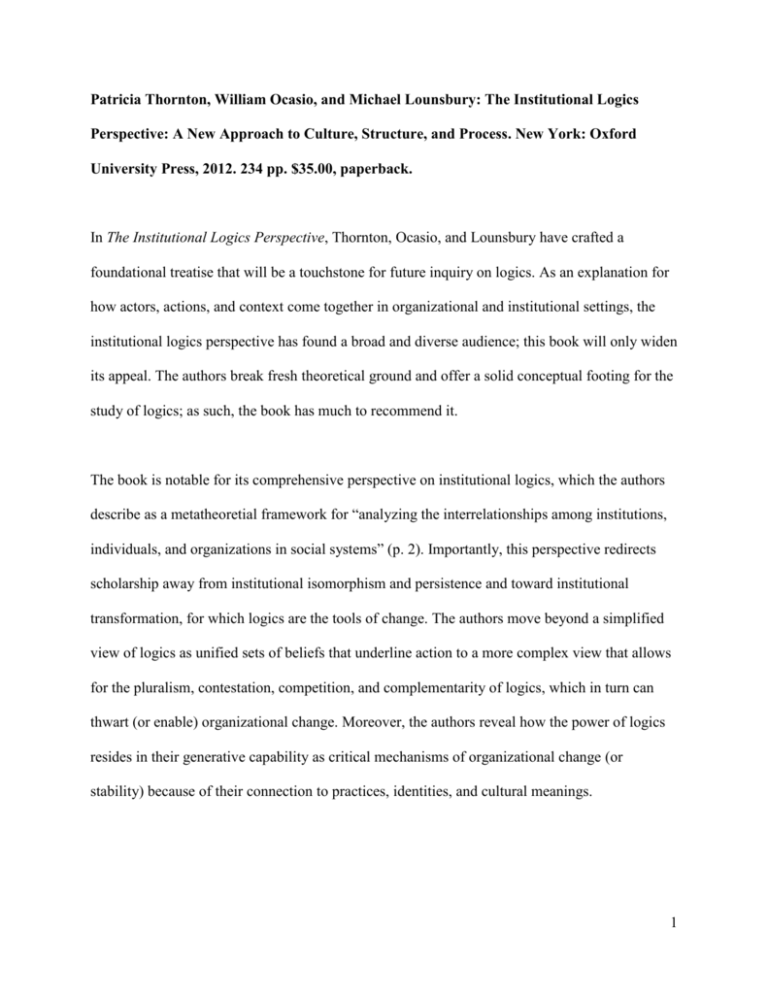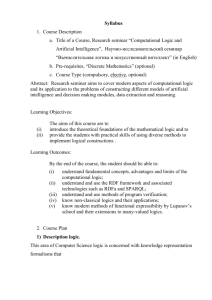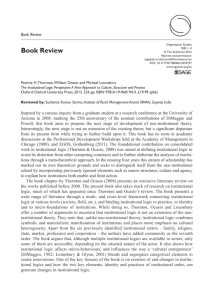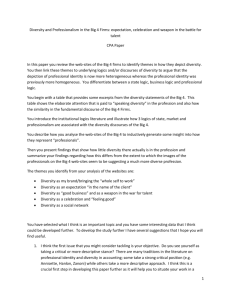ASQ Book Review - Patricia H. Thornton
advertisement

Patricia Thornton, William Ocasio, and Michael Lounsbury: The Institutional Logics Perspective: A New Approach to Culture, Structure, and Process. New York: Oxford University Press, 2012. 234 pp. $35.00, paperback. In The Institutional Logics Perspective, Thornton, Ocasio, and Lounsbury have crafted a foundational treatise that will be a touchstone for future inquiry on logics. As an explanation for how actors, actions, and context come together in organizational and institutional settings, the institutional logics perspective has found a broad and diverse audience; this book will only widen its appeal. The authors break fresh theoretical ground and offer a solid conceptual footing for the study of logics; as such, the book has much to recommend it. The book is notable for its comprehensive perspective on institutional logics, which the authors describe as a metatheoretial framework for “analyzing the interrelationships among institutions, individuals, and organizations in social systems” (p. 2). Importantly, this perspective redirects scholarship away from institutional isomorphism and persistence and toward institutional transformation, for which logics are the tools of change. The authors move beyond a simplified view of logics as unified sets of beliefs that underline action to a more complex view that allows for the pluralism, contestation, competition, and complementarity of logics, which in turn can thwart (or enable) organizational change. Moreover, the authors reveal how the power of logics resides in their generative capability as critical mechanisms of organizational change (or stability) because of their connection to practices, identities, and cultural meanings. 1 To start, Thornton, Ocasio, and Lounsbury state their aims as twofold: “. . . [first] to produce a primer that imparts a programmatic statement on the institutional logics perspective that distinguishes it from neoinstitutional theory and [second] to synthesize and propose novel theory to further flesh out the metatheory initially suggested by Friedland and Alford (1991)” (p. 1). The authors succeed admirably on both counts. First, as a primer, the book offers a supple and adaptable definition of the core construct: “. . . logics represent frames of reference that condition actors’ choices for sensemaking, the vocabulary they use to motivate action, and their sense of self and identity” (p. 2). Prominent in this definition is that logics are more than cognitive frames of reference; rather, they are action oriented, embedded in fields of meanings and constitutive of actors’ identities. Thus there is a tight coupling between logics and practices: logics become manifest in practices and, in turn, practices render logics transparent. An important jumping off point for the authors is the seminal article on logics by Friedland and Alford (1991) which associates particular logics with particular institutional orders, i.e., the cornerstone institutions or ideal prototypes in society. Friedland and Alford identified five of these in Western society—family, religion, market, democracy, and the bureaucratic state—and argued that each is characterized by a core logic that constitutes actors (both individuals and organizations) and society. Thus logics light the way to recognizing which actions are appropriate in each institutional order by typifying behaviors and structuring practices endemic to that order. Thornton, Ocasio, and Lounsbury elaborate Friedland and Alford’s (1991) core insights, adding two more institutional orders: community and profession. More importantly, however, they 2 decouple logics from institutional orders, which, I believe, is one of the book’s biggest contributions. Freeing logics from singular institutional orders frees researchers to explore logics in dynamic play, so that different types of logics can co-exist within organizations or be associated with different types of institutions, thereby defining organizations’ core identities and bounding the parameters of change. This enables Thornton, Ocasio, and Lounsbury to associate the logic of the market, for instance, with schools or nonprofit organizations, thereby accounting for the observed plurality of identities and practices. In turn, new research questions arise about the co-existence and compatibility of logics and how their affinity (or abrasion) may propel (or stall) organizational and institutional change. Disassociating logics from institutions is the gem here, because it sanctions a theorization of logics as flexible bits of culture that constitute actors and shape their actions. Opening this theoretical window freshens thinking about logics and neatly satisfies the authors’ second aim, that of proposing new theory. Another shining gem in the book is linking the logics perspective with other theoretical perspectives in organization studies. What this amounts to is filling in the blank to pair “logics and ______.” Three ways of filling the blank struck me as particularly promising: logics and organizational design, logics and practices, and logics and identity. Linking logics to organizational design illustrates not only how logics span but also how they penetrate multiple levels of analysis. The authors note how institutional logics at a higher level of analysis become embedded in organizations “via design” at a lower level of analysis (p. 181). Complementing this theorization is an alternative explanation: organization design can serve as a carrier of institutional logics that enable (or constrain) organizational action. And telescoping 3 beyond organizational design, the authors suggest that these embedded logics can make various organizational components connect and cohere better, because logics can pave over conflicts about goals, strategies, and mission. Linking logics to identities and practices leverages the natural affinity among these constructs: Logics supply both answer and justification to the identity question of “Who are we?” and the practice question of “What do we do?” As Thornton, Ocasio, and Lounsbury observe, “. . . from the inception of the institutional logics perspective, the concepts of practice and identity have been integral . . . [but] most research to date has not effectively analyzed how institutional logics shape and are shaped by the material instantiations of logics—the practices and identities of concrete actors" (p. 128). The book’s greatest single accomplishment, perhaps, is laying out the logics perspective clearly, a feat far more intricate and demanding than it may appear to the naïve. In doing so, the authors expand our field of inquiry by touching on some thorny issues. For instance, they take up the question of causality—of logics as independent or dependent variables—in their frequent mentions that logics have the potential to constrain or enable. Future work on logics might usefully elaborate the contingencies of when, how, and under what circumstances logics may lead change or follow from it. Another question arises around the operationalization of logics. The authors alert us to the potential of studying practices, which can serve as sites that can tap into the modalities whereby logics are instantiated in materiality, behaviors, practices, languages, and symbols. 4 With their book, Thornton, Ocasio, and Lounsbury have taken on quite a task: to articulate an analytical, metatheoretical framework of a construct laden with meanings that cut across the academic and the everyday—with an intuitive appeal and a confounding breadth—and that can, in one swift sweep, move from the individual to the organizational to the institutional. Whew! It is fortunate for us, and for the field, that they have succeeded. Mary Ann Glynn Department of Organization and Management Carroll School of Management Boston College Chestnut Hill, MA 02467 maryann.glynn@bc.edu REFERENCE Friedland, R., and R. Alford 1991 “Bringing society back in: Symbols, practices, and institutional contradictions.” In W. W. Powell and P. J. DiMaggio (eds.), The New Institutionalism in Organizational Analysis: 232– 263. Chicago: University of Chicago Press. 5








